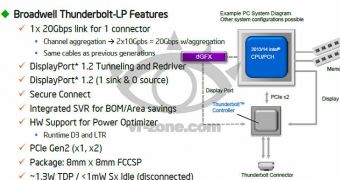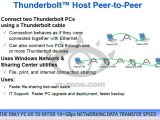Thunderbolt continues to be a rather underutilized connectivity interface, despite Intel's and Apple diligence in its promotion, but the new specification expected to come into practice in 2014 might help things move forward.
Not that it's all that shocking that a relatively new technology failed to gain traction when the Universal Serial Bus has been around for so much longer.
True, Thunderbolt is twice as fast already, at 10 Gbps versus the 5 Gbps of USB 3.0, but it also has a different port which, in turn, needs devices (phones, portable HDDs/SSDs/flash drives, etc.) to be designed specifically with TB in mind.
It's just not been going that well. Thunderbolt hasn't been doing badly, exactly, but it hasn't really spread outside Apple's ecosystem either, not that much.
Only people who plan to daisy-chain storage drives or use Thunderbolt to stream video to monitors (multiple at once even) have special incentive to get it.
And performance for flash storage units is mostly up to the controller processor and NAND Flash chips anyway, which means that the half-bandwidth of USB 3.0 isn't stifling them, hence the lack of need for Thunderbolt.
Intel is determined to see this change, however, so it has been working hard on the Broadwell Thunderbolt-LP controller.
It will enable motherboards to support 20 Gbps links by aggregating two 10 Gbps channels. Thus, it relays DisplayPort signals from the graphics device integrated into the CPU (connects to the system via PCI Express 2.0 x2).
The TDP rating will be of 1.5W, 1 mW for idle mode, but power delivery over a tethered cable will be allowed too, for up to 53W (so you can recharge devices with it, like with USB 3.0, or run drive docks with up to six 3.5-inch HDDs, even 24-inch monitors without power cables).
Ad-hoc networking is another special feature, allowing peer-to-peer 20 Gbps connections between two PCs. Good for content creation, even if it will never replace LAN.
Intel will demo the Thunderbolt controller at CES 2014, in January, but will have to contend with USB 3.1, which will go from 5 Gbps to 10 Gbps.

 14 DAY TRIAL //
14 DAY TRIAL // 
